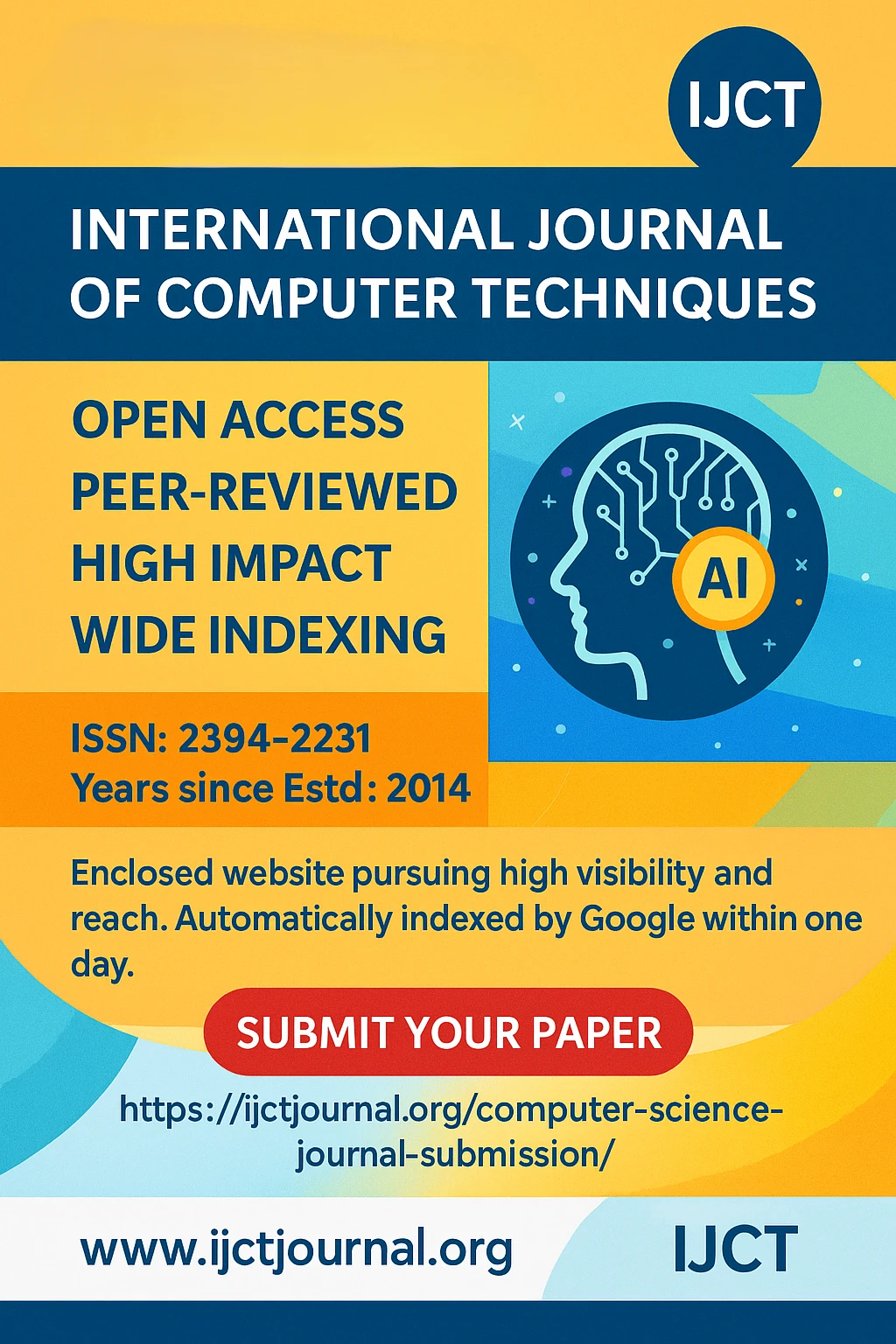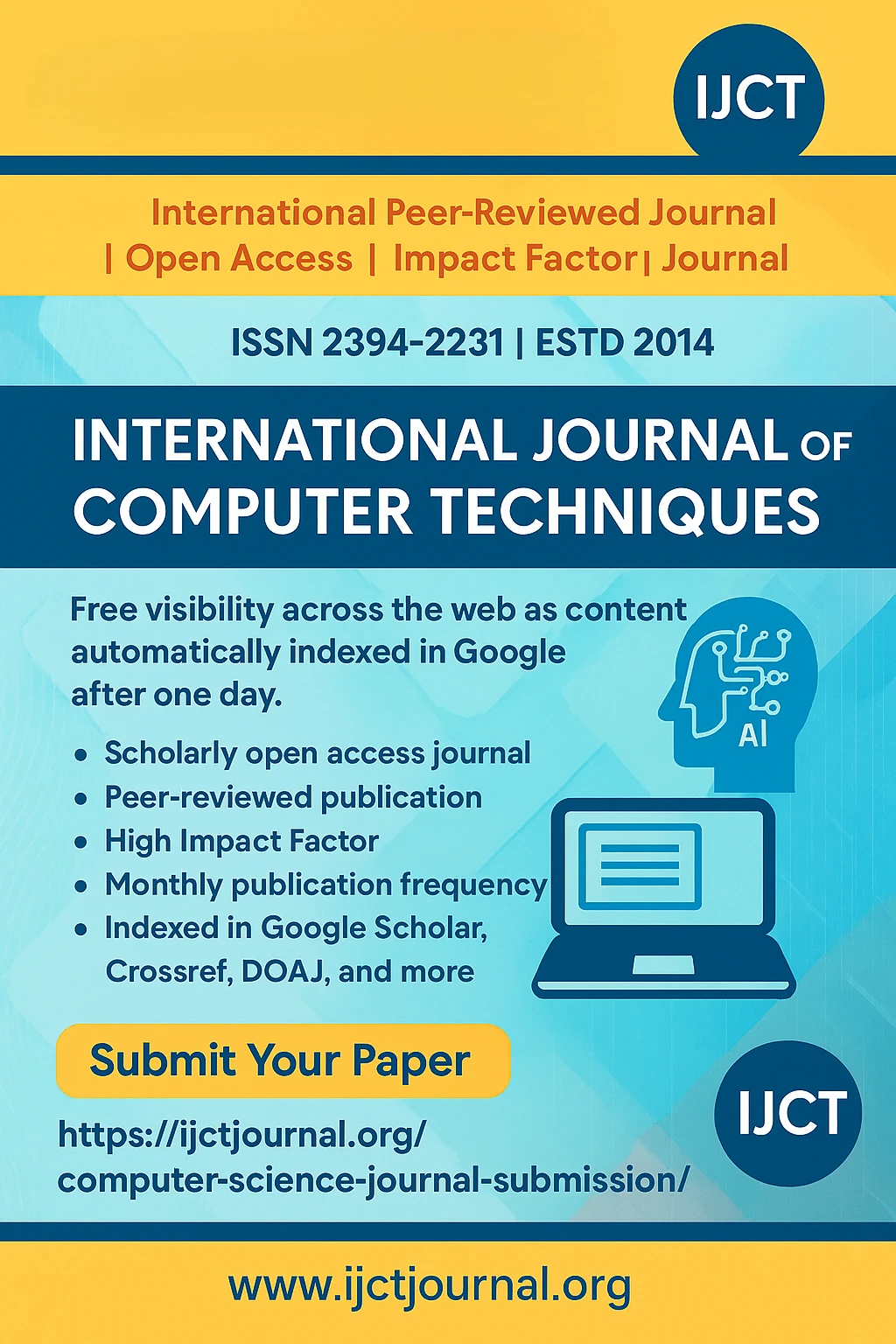
Campus Utility App: A Secure, Real-Time Platform for a Collaborative Campus Community | IJCT Volume 12 – Issue 5 | IJCT-V12I5P65

International Journal of Computer Techniques
ISSN 2394-2231
Volume 12, Issue 5 | Published: September – October 2025
Author
Dr. K. Sundara Velrani, Mahendiran Marimuthu, MadhanKumar V, M Abishanth Jegan
Table of Contents
ToggleAbstract
This paper presents the end-to-end development of a secure and responsive Campus Utility Web Application designed to address common logistical challenges faced by students. The system integrates modern frontend and backend technologies to provide two core modules: a privacy-centric Lost & Found system and a peer-to-peer Item Borrowing network. Built with React for the frontend and Google Firebase for backend services, the application ensures real-time data synchronization, secure user authentication, and a seamless user experience across all devices. This paper covers the detailed methodology, system design, core functionalities, security implementation, and performance evaluation. The proposed system provides a robust framework for creating a more connected, resourceful, and collaborative campus environment.
Keywords
campus utility app, React.js, Google Firebase, Firestore, real-time database, web application, Lost & Found, peer-to-peer, student communityConclusion
The Campus Utility App offers a modern, secure, and efficient solution to common logistical problems that students encounter. It uses React for a dynamic front-end and Google Firebase for a real-time, scalable backend. This setup provides a strong user experience centered on privacy and community collaboration. Features such as private messaging and administrative oversight create a safe space for students to interact and support each other.Future work could include adding a real-time chat feature to the app, sending push notifications for mobile devices, and using machine learning to automatically categorize posts. Ultimately, this project shows how targeted web applications can greatly improve campus life.The thorough evaluation of the proposed Campus Utility App showed it can provide a reliable, secure, and efficient solution to common issues in a university setting. Integrating a modern frontend framework (React) with a powerful Backend-as-a-Service platform (Google Firebase) created a responsive and scalable system. Extensive testing confirmed that the platform keeps real-time data accurate, offers quick response times, and has strong data protection, which are essential for a community-based application. The main modules for Lost & Found and Item Borrowing met their goals, giving a structured and private alternative to informal methods. Additionally, user feedback showed that the platform has a user-friendly interface, bringing together essential tools into one convenient system. The results of this work show that the proposed framework effectively connects the practical needs of students with the abilities of modern web technology. By combining secure authentication, real-time database operations, and a design focused on privacy, the system provides a smooth and user-centered experience. The component-based structure also allows for flexibility, making it easy to add new modules in the future. This ability to adapt is important for educational institutions looking to improve the student experience through digital changes.
Despite these achievements, several limitations were noted that indicate a clear direction for future development. The current implementation is limited to one language and lacks native push notifications, which would boost engagement. The absence of a real-time chat feature and better search filters are also drawbacks. Tackling these areas would significantly improve the platform’s functionality and usefulness in real-life scenarios.Future work should focus on overcoming these challenges. Developing dedicated mobile apps for iOS and Android would increase accessibility and user engagement. Adding a real-time chat service and better filtering options would improve the user experience. Including new modules for other campus needs, such as event management or a student marketplace, could turn the app into a comprehensive campus hub.
References
A. Ahmed and S. K. Singh, “A Survey on Real-Time Data Synchronization Techniques in Modern Web Applications,” IEEE Access, vol. 9, pp. 81345–81360, 2021. A. Al-Emran and V. K. Singh, “A Survey of the Usability of University Mobile Applications,” in Proc. IEEE Global Engineering Education Conference (EDUCON), 2020, pp. 1435–1442. A. Brown, “Component-Based Architecture in Modern Frontend Development,” IEEE Software, vol. 38, no. 3, pp. 25–31, May–June 2021. J. Banks and D. North, React and React Native: A Complete Guide to Modern Web and Mobile Development, 4th ed., O’Reilly Media, 2022. J. Brooke, “SUS: A ‘Quick and Dirty’ Usability Scale,” in Usability Evaluation in Industry, P. W. Jordan, B. Thomas, and B. A. Weerdmeester, eds., London, UK: Taylor & Francis, 1996. H. Chen, “Security and Privacy in Cloud-Based Backend Services for Mobile Applications,” IEEE Security & Privacy, vol. 19, no. 4, pp. 72–78, 2021. D. Crockford, “The JSON Data Interchange Format,” RFC 7159, Internet Engineering Task Force, 2014. [Online] T. H. Cormen, C. E. Leiserson, R. L. Rivest, and C. Stein, Introduction to Algorithms, 3rd ed., MIT Press, 2009. M. Fowler, Patterns of Enterprise Application Architecture. Addison-Wesley, 2002. S. Franklin and Z. Graesser, “Is it a Lost Cause? A Model of Student Behavior in Lost and Found Systems,” Journal of College Student Development, vol. 58, no. 7, pp. 289–304, 2017. “Google Firebase Documentation.” Google LLC. [Online]. Accessed: Oct. 12, 2025. “Google Firestore Security Rules.” Google LLC. [Online]. Accessed: Oct. 12, 2025. R. Gupta and P. Kumar, “Building Scalable Web Applications using Backend-as-a-Service (BaaS),” in Proc. IEEE International Conference on Cloud Computing (CLOUD), 2022, pp. 345–352. P. J. Johnson and A. B. Miller, “The Role of Peer-to-Peer Networks in Fostering Collaborative Campus Environments,” Computers & Education, vol. 168, art. no. 104198, 2021. S. Krug, Don’t Make Me Think, Revisited: A Common Sense Approach to Web Usability, 3rd ed., New Riders Publishing, 2014. C. Li and J. Wang, “Privacy-Preserving Mechanisms in Location-Based Social Applications,” IEEE Transactions on Information Forensics and Security, vol. 16, pp. 2345–2356, 2021. P. Morville and J. Callender, Search Patterns: Design for Discovery. O’Reilly Media, 2010. J. Nielsen, Usability Engineering. Morgan Kaufmann, 1994. A. Oram, Ed. Peer-to-Peer. Harnessing the Power of Disruptive Technologies. O’Reilly & Associates, 2001. R. S. Pressman and B. R. Maxim, Software Engineering: A Practitioner’s Approach, 9th ed., McGraw-Hill Education, 2020. C. Richards, JavaScript and jQuery: Interactive Front-End Web Development. John Wiley & Sons, 2014. J. Smith and R. Williams, “A Study of User Engagement in University-Specific Mobile Applications,” in Proc. ACM Conference on Human Factors in Computing Systems (CHI), 2021, pp. 1–12. I. H. Witten, E. Frank, M. A. Hall, and C. J. Pal, Data Mining: Practical Machine Learning Tools and Techniques, 4th ed., Morgan Kaufmann, 2016. L. Wong and H. Lee, “The Impact of Real-Time Notifications on User Experience in Collaborative Web Platforms,” Journal of Human-Computer Interaction, vol. 36, no. 4, pp. 305–328, 2021. “React – A JavaScript Library for Building User Interfaces.” Meta Inc. [Online]. Accessed: Oct. 12, 2025.
Journal Covers
IJCT Important Links
© 2025 International Journal of Computer Techniques (IJCT).











